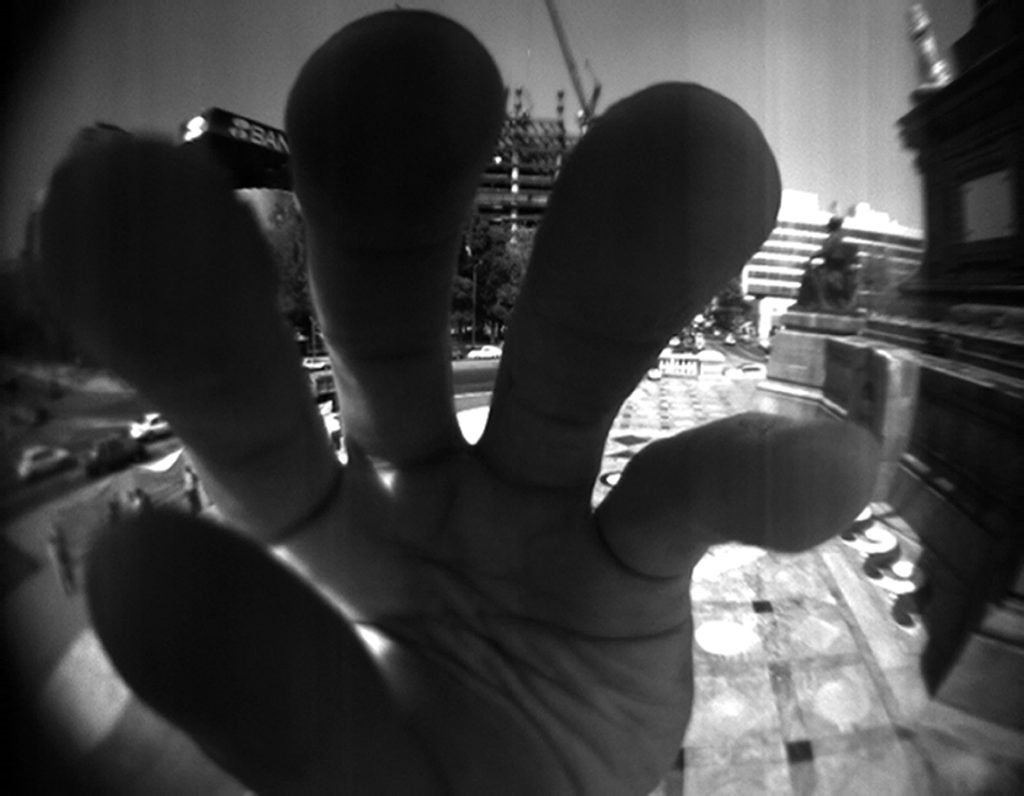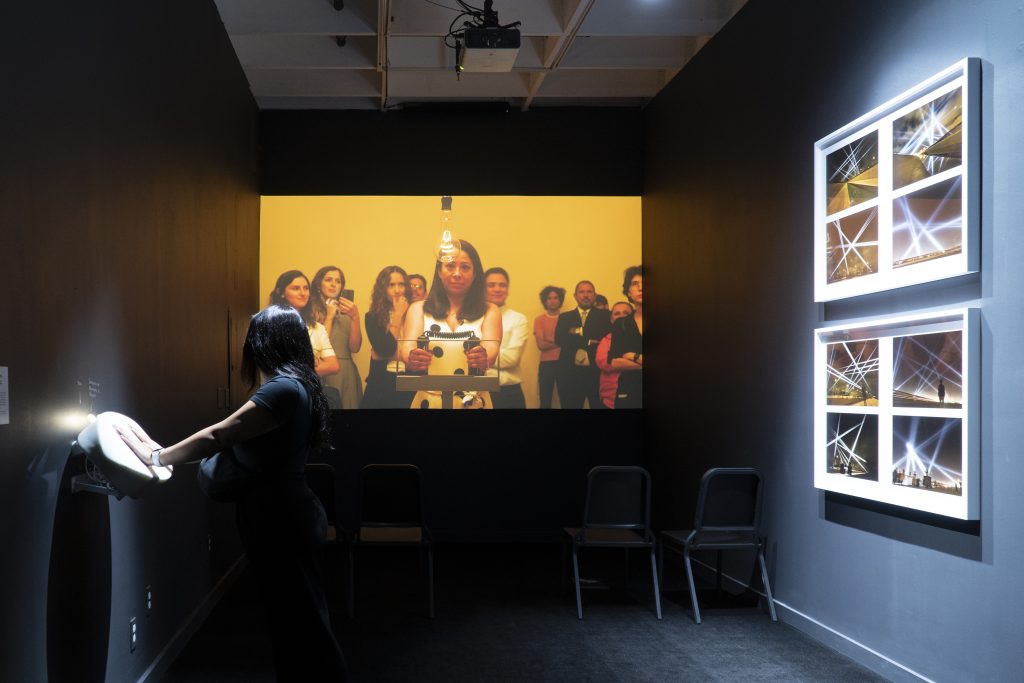Rafael Lozano-Hemmer’s “TECHS-MECHS” Re-Defines Innovation
At San Francisco’s Gray Area, immersive and interactive artworks reclaim surveillance technology

One of the first oral contraceptives was created by Luis Miramontes in Mexico, a nation that’s home to a large number of innovative precedents. Evidence of climate change in the ozone layer, an electronic music synthesizer, virtual reality—all of these and more were first developed in Mexico, but many people in the Western World don’t perceive it as a nation with a high output of trailblazing inventions. “Oftentimes, we think of Mexico… as being on the receiving end of innovation and technology,” says multidisciplinary electronic artist Rafael Lozano-Hemmer. “We almost speak of these countries as being colonized by a new wave of innovation, but what the research shows is that there is a lot of innovation [and] a lot of technology that emerges from Mexico and other countries like it.” These accomplishments form the background of his latest show, TECHS-MECHS: A Survey of Mexican Technological Culture, on now through 31 May at San Francisco’s Gray Area (where viewers receive a booklet listing these technologies as well).

“For a long time I’ve been collecting short little landmarks or studies or patents or inventions that have taken place in Mexico, and the context of the work is called ‘Techs-Mechs’—like ‘Tex-Mex’ but this time we write it ‘T-e-c-h-s-M-e-c-h,’ because we’re trying to break certain stereotypes over what it means to be Mexican,” says Lozano-Hemmer, who was born in Mexico and immigrated to Canada. The immersive, electronic exhibit brings Mexico’s long history of advancements to light—some of which are overlooked or unrecognized. “For example, corn would not exist were it not artificially selected by Mesoamerican and Columbian cultures from grass. This is not a naturally occurring thing. It is literally a technology,” explains the artist.

“The purpose of this is not to pretend that whoever is first is the best,” he continues. “It’s not a patriotic thing. It is simply a device, especially when showing in Silicon Valley, for people who are there have this very frontiersman mentality of innovation: ‘We’re the first, we’re disrupting things, we’re inventing things.’ I think it’s really important to take a step back and understand that this is a global phenomenon.”

The 10 works in the show draw from Mexico’s cultural and technological production. In “Volute Zero,” for instance, the artist combines contemporary technology and Indigenous speech volutes found on scrolls. “Volute is basically like a turbulence that is ejected from your mouth. As you’re speaking, you’re generating this air that used to be private and now it’s public, as [Indigenous people] would represent that with these volutes that were very accurate according to fluid dynamics,” says Lozano-Hemmer. He then visualizes what is typically invisible by using laser tomography to measure density slices in the air (which are different when somebody is speaking). These are then captured digitally in a video and 3D-printed in stainless steel.

“So ‘Volute Zero’ is basically the world’s first 3D-printed speech-bubble, and a couple of things that I really love is that even the same person saying the same thing will give you a completely different shape. The shape is printed in stainless steel, almost as a kind of artifact. I’m always [trying to] make visible the intangible forms that surround and inform us,” he says. By virtue of melding forms of innovation—both contemporary 3D printing and ancient volutes—Lozano-Hemmer comes into his own kind of precedent.

Putting Mexican technology and innovation at the forefront was especially important, given the locations of the exhibit. “The Mission District is traditionally a Latino, Latinx, Latin American, Mexican American center. It’s where you hear Spanish, it’s where the community hangs out, but it’s also a site of intense duress due to gentrification and to the degree that artists are helpful in that gentrification. Gray Area is a media art center in the middle of the Mission District in a beautiful theater, and what I thought was really prudent was to try and make a set of installations which would reconnect this media art to the community. That kind of identitarian approach (which I hate normally) was important to bring here only because I have a feeling that we need to acknowledge our own complicity in what we denounce, which is gentrification,” explains Lozano-Hemmer.

The artist’s methodology reveals a pathway toward working and living with his medium: technology. Amongst the works on view (including the immense, immersive biometric installation “Pulse Topology“) re-appropriation and reclamation are front and center. In “Thermal Drift,” the thermal cameras used to track people at the US-Mexico border or at malls for shoplifting are repurposed into an interactive artwork that humanizes the subjects. The camera depicts the heat generated from each person and generative software makes each particle visible. As participants interact with the screen, the billowing particles dissipate into one another and the atmosphere, linking people together and with the world around them.

Where “Thermal Drift” playfully refashions surveillance technology (while acknowledging its power for violence), other works like “Inspired By Real Events” take a more directly subversive stance. “That’s quite an old project,” Lozano-Hemmer tells us. “It’s now 20 years old, and it was basically the documentation of an intervention I did in public space in Mexico City. In 2003, we went looking for important surveillance video cameras in Mexico in emblematic places like El Ángel de la Independencia or Independence Angel. We brought a ladder and asked volunteers to go and turn off the cameras, and so what the video is recording is people going up this ladder putting their head, their face, in front of the camera and literally turning it off and you have these deformed fingers just reaching out.”

“That’s an example of a project from a long time ago, which I’m happy to show because I keep thinking that people, especially techno-optimists, think that the solution to a lot of our problems like crime or terrorism is technology,” he explains. “The truth is anybody with some common sense knows that the solution to those problems is things like redistribution of wealth, translation, diplomacy, decolonization.”

On one hand, TECHS-MECHS is a survey of the technology that has come out of and impacted Mexico, but on the other hand it asks: what do you do with information? Where do we go from here? Far from shy, the exhibit is upfront about the ways technology acts as another layer of oppression.
“The way I see it, technology is not really a tool, but rather a language—and it’s an inescapable language,” he says. “I often say that I work with technology not because it’s new, but because it’s the medium through which our war, our economy, our relationships are mediated. To work with technology is just to be consistent, coherent with what is natural. To investigate technologies is to investigate ourselves.”
Images courtesy of the artist/Gray Area












